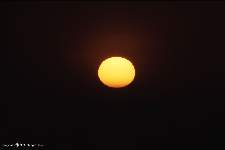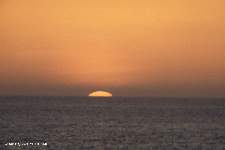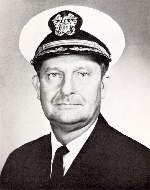
I suppose every naval officer has some key figure that they encountered in their career who represents the ideal of what a naval officer should be. For me, this was Captain Jay Stanley Howell, Commanding Officer of the USS Oklahoma City from September, 1969 through February, 1971.
Captain Howell graduated from the U.S. Naval Academy in 1943, and served through the end of World War II. He began post graduate studies in 1947 at Annapolis, then earned a Masters degree in Physics from the Massachusetts Institute of Technology. After this he served at Los Alamos working in special weapons research and development.
Most of his Naval career was spent on ships, ranging from destroyers to battleships. More important, from my standpoint, he had served 12 years on cruisers by the time I came aboard the Oklahoma City. He could drive a 15,000 ton cruiser like it was a sports car. Although I thought his academic accomplishments were impressive, it was his ship handling ability that I respected the most.
Trash overboard!
A few weeks after arriving on the Okie Boat I was summoned to the bridge one day by the call on the 1MC "All junior officers not on watch report to the bridge." We were steaming off Okinawa, waiting for the Admiral to arrive by helo. The Captain decided to conduct junior officer training, practicing ship handling during man overboard drills. He instructed the bosun to wait a few minutes and then throw a trash bag overboard. Meanwhile Captain Howell sat in his chair reading messages on a clipboard.
"Trash overboard" the bosun shouted, and sounded the man overboard signal. Captain Howell ordered "Right standard rudder" and looked at his watch. Then he continued to read messages, occasionally checking his watch. After a while he ordered "Rudder amidships."
We continued on the reverse course a few minutes, while the Captain read messages and checked his watch. Soon he ordered "Right standard rudder" again, followed a minute or two later by "Rudder amidships, all stop." We watched as the ship came out of the turn and steadied up with the trash bag dead ahead. The ship slowed as it approached and the bag came down the starboard side rubbing against the hull. A bosun's mate climbed down the side on a rope ladder and caught the bag as it slowly passed.
Impressive as this was, it became more so after the junior officers gave it a try. I think the best any of us did was to bring the ship around to within 30 yards of the bag. The motor whale boat was lowered to retrieve it. Of course, this was good enough. If you had fallen overboard you wouldn't quibble over whether you were rescued by someone on the ladder or by the boat crew. But for the junior officers it engendered tremendous respect for the "old man's" ship handling skills.
No paint scratched
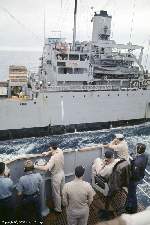
Underway replenishment (UNREPS) was a special test of a deck officer's ship handling ability. Steaming close alongside another ship, matching course and speed exactly, called for constant attention to details. The replenishment ship set the course and speed, and we had to hold station alongside while receiving fuel, supplies and ammunition.
A distance line ran from one ship to the other, with colored flags every 20 feet or so. The Officer of the Deck (OOD) who was driving the ship watched the position of the flags to determine the distance between the ships. To match speed we watched the relative motion of features on the other ship to see if we were moving faster or slower. Maneuvering orders were given in single degrees of rudder movement and one or two revolutions per minute changes for the propellers. It was far more demanding than ordinary free steaming.
One nice sunny afternoon we were taking on fuel, supplies and ammunition from one of the new AOE class replenishment ships alongside to starboard. It was about 200 feet longer than we were and quite a bit larger than the Oklahoma City. I took some time off to go topside to watch the action and take pictures. After a while I had to go back below to stow my camera before I went on watch on the bridge. Suddenly the collision alarm sounded throughout the ship. We closed all the water tight doors and hatches and waited, but nothing more happened. Then the all clear signal came through and I went to the bridge.
The helmsman on the replenishment ship had fallen asleep at the wheel, and the ship turned toward us. The two ships, 600 and 800 feet long, were steaming only about 100 feet apart before the distance began closing. Seeing what was happening the OK City OOD ordered emergency breakaway, causing all lines and hoses running between the ships to be cut. Then we began a slow turn to port away to avoid collision. When we sounded our whistle to warn the other ship of our maneuver their helmsman woke up and swung his wheel over hard, causing the replenishment ship to make a sharp turn to starboard away from us.
Ships do not move like automobiles. When you turn the rudder the ship continues to plow ahead for a few moments while the rudder swings the stern around and the hull rotates around the center of mass amidships. Then the greater force of the water against the leading side of the hull pushes the ship aside as if it was sliding sideways on ice. The result is that the bow turns in the direction of the turn, but the stern swings in the opposite direction.
When we made our turn away from the replenishment ship our stern actually swung closer. Likewise, when they made their sharp turn their stern swung rapidly toward us. So as our bows moved apart the sterns came closer together. The ship's Chief Bosun CWO Hal Black was on the fantail directing supply transfers by helicopter, and watched as the two ships moved closer and closer together. He reported that the propeller guards came within a foot of each other before the ships started moving apart!
Now, if you want to make a Captain twitchy, just give him a situation where the props might be damaged. Without propellers a ship isn't much more than a floating flower planter. Damaging a propeller is just about the worst thing a Captain can do short of losing the entire ship.
A short while later I was on watch on the bridge, and since I had missed the action I asked for details. The Captain repeated Hal Black's report, emphasizing the narrow miss between the propeller guards. To this I replied flippantly "Hey, an inch is as good as a mile - no paint scratched." The Captain looked at me for a moment or two, and said "Mr. Hays, I'm not sure I want you driving my ship!"
The Admiral's coffee
Aristotle
(A line penciled on the wall of a watch station at Naval Officer Candidate's School)
One clear sunny day we were steaming off the Okinawa coast waiting for the arrival of a helicopter transferring personnel. I was Junior Officer of the Deck (JOOD) in training to be OOD, and I had the conn (I was driving). It was a slow day and not much was happening. The only other traffic was a single freighter off our starboard bow that we were slowly overtaking. The range was closing, but the bearing was swinging aft, so we were not on a collision course. The other ship eventually passed a thousand yards or so off our starboard beam and fell astern.
After a while Captain Howell decided to reverse course and move back toward the center of the rendezvous area. So I took a look off our port side to be sure it was clear, ordered left standard rudder and gave the new course to steady on. Then I walked to the port side open bridge to observe the turn. It took a few seconds to cross the bridge to get to the open wing. I checked the binnacle to follow the turn and noticed that we were swinging to starboard. I looked at the rudder angle indicator and realized to my horror that it indicated right standard rudder - we were turning across the bow of the other ship!
I ran back into the pilot house and asked the OOD if he had given a rudder order - he had not. I looked at the Captain and realized from his startled look that he had not either. Then I shouted "Left full rudder!" as forcefully as I could as I ran to the starboard side to see how close we were to the other ship. The Okie Boat gradually began to swing around away from the freighter and start the turn to port.
I was actually quite frightened, and the doubt flashed through my mind that I might have given the wrong helm order that could have caused a collision. The Captain watched the relative motion of the two ships for a moment and realized that there was no danger, then calmly said to me "Mr. Hays, ease your rudder to left standard. We don't want to spill the Admiral's coffee."
The calm way Captain Howell took in all of this caused me to relax a bit while the ship finished the turn. Then I asked the bosun to read back the helm orders. All orders given on the bridge are recorded in the ship's log along with the time they are given. To my relief he had recorded my initial "left standard rudder" order. I hadn't screwed up - the helmsman had forgotten left from right. The last thing I would want to do is explain to the Captain why I had turned his ship across the bow of another ship, especially one that had the right of way!
The green flash
Late one afternoon I was standing duty as JOOD on the bridge. It was a very clear day with a calm sea and no haze on the horizon. I had taken special notice, because I was waiting for the sun to set, hoping to observe a rare phenomenon. Before entering officer training I decided to read as much as I could about naval tradition, ship handling and navigation. The standard reference for navigation was Nathaniel Bowdich's American Practical Navigator. This three inch thick tome contains just about everything to know about celestial navigation, including extensive descriptions of atmospheric conditions. One of the more unusual conditions is the green flash, a phenomenon occasionally observed at sunset on exceptionally clear days.
A few minutes before sunset Captain Howell had the bosun call all junior officers not on watch to the bridge, and instructed him to issue binoculars to everyone. Then he addressed the group and asked if anyone had any idea why he had called them to the bridge. No one else said anything so I asked "Are we going to see the green flash?" Some of the JOs chuckled a bit because they knew I had a sometimes out of place sense of humor. But the Captain looked at me with obvious surprise. "How do you know about the green flash?" he asked, and I explained that I had read Bowdich. I think I got a gold star for that. He had, indeed, called everyone to the bridge with hopes that we would observe the flash. And since I seemed to know all about it he asked me to explain it to my less knowledgeable peers.
The atmosphere refracts light coming from the sun, just like a prism. At sunset the light passes horizontally long distances through the atmosphere, so the effect is greatest. This is why the sun changes color from white when directly overhead, through yellow and orange to red just as it sets. The air also scatters blue light more than red, adding to the effect. On most days humidity in the air absorbs all of the green, blue and violet light at sunset, and all we see is orange and red. But on exceptionally dry and clear days some of this light gets through. When this happens, multiple colored images of the sun appear one above the other, just like the colors of a rainbow. The red image is largest and brightest so this is all you can see until it drops below the horizon. Then, for a second or two a thin sliver of bright green shines above the horizon. If the air is extraordinarily clear, a very dim blue-violet image may be seen after the green image disappears. I have observed the green flash several times, and even managed to photograph it once (no small feat from the rolling deck of a ship!).
Something strange
The green flash event caused me to realize that Captain Howell took special interest in natural phenomena that most people would ignore. This led to another small adventure. One night I was on the bridge for the mid watch from 0200 to 0400. We were steaming in the Gulf of Siam with clear skies and calm seas. The Captain was asleep in his sea cabin, just a step from the bridge. About half an hour into the watch the phone talker told me the starboard lookout reported "something strange" in the sky. I immediately wondered if the guy had been smoking an illegal substance.
I stepped out to the starboard open bridge and looked up to see an amazing sight. An enormous comet spread across at least one third of the sky, from the bright head to where the tail faded from view! The tail fanned out at about a 30 degree angle, creating an image more spectacular than any I have seen in astronomy books. I stared at it for a few minutes before resuming my ship driving duties. Occasionally I had to step outside and look again, because I knew this could be a once in a lifetime sight.
Then I remembered the green flash event, and figured Captain Howell would want to see this for himself. However, you don't wake the Captain from a
good sleep for trivial reasons. So I thought about it for a while, and decided to take the chance that he wouldn't be angry. I called him on the phone
and said there was something that I thought he should see.
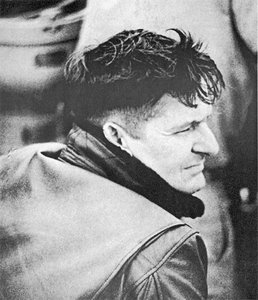
Normally if someone wakes the Captain there is something wrong, so as he came onto the bridge he asked me what was happening. I told him to step outside and look up. He looked at me as if thinking this had better be worth interrupting a sound night's sleep, and stepped outside. He stayed there for at least fifteen minutes, looking at the comet. When he came back in he said "Thank you Mr. Hays," and went back to bed. I figured it was fair payment for having shown me the green flash.
There are two kinds of officers, leaders and pushers. Both can get the job done, but there is a great difference between the two. Pushers use orders and bullying to force subordinates to do the things that need to be done, but they do it begrudgingly. Leaders can merely express a desire to have something happen and their subordinates willingly comply.
Captain Howell was an officer and a gentleman. More importantly, he was a leader. He instilled confidence and respect in those who served under him. All he had to do was comment that something should be done and you would go out of your way to see that it was done, and done right. It was a pleasure to serve under his command.

